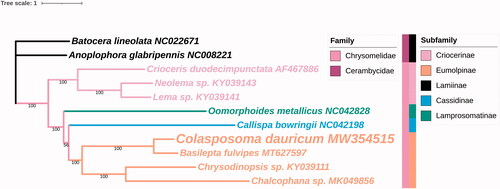Abstract
Colasposoma dauricum Mannerheim, 1849, is an important insect pest distributed in most areas of China. The complete mitochondrial genome of C. dauricum was sequenced and analyzed. The phylogenetic relationships between C. dauricum and other 10 species in the superfamily Chrysomeloidea were reconstructed using maximum likelihood (ML) methods based on the concatenated nucleotide sequences, the phylogenetic analysis showed that C. dauricum is closely related to Basilepta fulvipes in the same subfamily.
Colasposoma dauricum (Coleoptera: Chrysomelidae: Eumolpinae) is a polyphagous insect widely distributed in North and Northeast China (Montagna et al. Citation2016). In China, the native area, it feeds on different species of Convolvulaceae, Asclepiadaceae and Apocynaceae (Ahn and Lim Citation1991; Jolivet and Hawkeswood Citation1995). Pest survey in Artemisia argyi plants, reported serious damage caused by C. dauricum. Previously published mitochondrion genome of C. dauricum GenBank: KY039104.1 was partial. In this study, the mitogenome was complete, supplementing the sequences of NADH1, tRNA-Leu, 16S RNA, tRNA-Val and 12S RNA.
The specimen in this study was collected from Huanggang City (Hubei Province, China) (115°45′78″E, 31°13′94″N) in 2020 and deposited in the Biodiversity Herbarium of Huanggang
Normal University (no. HGNU-QA1; Email contacts of the people in charge of the collection: [email protected]). The adult sample, with total weight of about 0.2 g, was used for experiments. Salting-out method was used to extract the sample DNA. The obtained pure DNA was used to construct a genomic library and to start high-throughput sequencing using Illumina HiSeq X. The sequences were assembled using SPAdes v3.11.19 (http://cab.spbu.ru/software/spades/) and annotated using MITOS web server.
PhyloSuite (Zhang et al. Citation2020) was used for the phylogenetic analyses with several plug-in programs: MAFFT (Katoh and Standley Citation2013) using ‘-auto’ strategy and codon alignment mode. PartitionFinder2 (Lanfear et al. Citation2016) was used to select best-fit partitioning schemes and models using AICc criterion. The number of bootstrap replicates was 5000, and Maximum likelihood phylogenies were inferred using IQ-TREE (Minh et al. Citation2013; Nguyen et al. Citation2015). The topology of the trees were visualized and edited in iTOL (Letunic and Bork Citation2019).
The complete mitogenome of Colasposoma daurium is 15,490 bp in size (GenBank accession number: MW354515). It includes 13 protein-coding genes (PCGs), 22 tRNA genes and 2 rRNA genes, a total of 37 genes. There are 14 gene overlapping regions in the genome. The total overlapping length is 459 bp, ranging from 1 to 345 bp. The longest overlapping region (345 bp) located between 16 s rRNA and trnV. There are 6 intergenic spacers with a total length of 44 bp, the longest intergenic 22 bp located between trnS and ND1. The genomic nucleotide composition is A:T:C:G = 40.11%:34.14%:14.90%:9.76%. The total length of 13 PCGs in the mitochondrial genome is 11,096 bp. The start codons of twelve PCGs were the same with that of C. dauricum GenBank: KY039104.1. The newly announced gene, nd1, began with TTA. The stop codons of nine genes (nd2, cox1, cox2, atp6, nd3, nd5, nd4L, nd6, and cytb) are the same as those previously published. The stop codon of atp8, cox3 and nd4, changed from ATA to TAA, GGT to ATA, CAT to TAT, respectively. The gene, nd1, is terminated by CAA. The length of tRNA genes ranged from 63 to 72 bp, 1459 bp in total length. The length of 12S rRNA and 16S rRNA are 833 and 1660 bp in length, respectively.
The concatenated nucleotide sequences of 13 PCGs from nine leaf beetles in family Chrysomelidae and two outgroups (Anoplophora glabripennis NC008221 and Batocera lineolata NC022671 in family Cerambycidae) were used to construct the phylogenetic tree. The phylogenetic analysis showed that C. dauricum is closely related with Basilepta fulvipes MT627597, both belong to the same subfamily Eumolpinae, which is in accordance with the traditional morphological classification (). This result is also consistent with previous phylogenetic analyses in other Eumolpinae insects (Feng et al. Citation2020).
Disclosure statement
No potential conflict of interest was reported by the author(s).
Data availability statement
The data that newly obtained at this study are available in the NCBI under accession number of MW354515 (https://www.ncbi.nlm.nih.gov/nuccore/MW354515). The associated BioProject, SRA, and Bio-Sample numbers are PRJNA758734, SRP334637, and SAMN21033541 respectively.
Additional information
Funding
References
- Ahn SB, Lim SE. 1991. Leaf feeding species on soybean and sweet potato. In: Crop insect pests in Cheju Island. Research reports of the rural development administration; 33:46–50.
- Feng RQ, Zhang LJ, Li M, Liu J, Wen CL, Yuan ML. 2020. Mitochondrial genome of Chrysochares punctatus (Coleoptera: Chrysomelidae: Eumolpinae) and phylogenetic analysis. Mitochondrial DNA B Resour. 5(1):667–668.
- Jolivet P, Hawkeswood TJ. 1995. Host-plants of chrysomelidae of the world: an essay about the relationships between the leaf beetles and their food-plants. Ann Vasc Surg. 10(4):361–364.
- Katoh K, Standley DM. 2013. MAFFT multiple sequence alignment software version 7: improvements in performance and usability. Mol Biol Evol. 30(4):772–780.
- Lanfear R, Frandsen PB, Wright AM, Senfeld T, Calcott B. 2016. PartitionFinder 2: new methods for selecting partitioned models of evolution for molecular and morphological phylogenetic analyses. Mol Biol E. 34:772–773.
- Letunic I, Bork P. 2019. Interactive tree of life (iTOL) v4: recent updates and new developments. Nucleic Acids Res. 47:256–259.
- Minh BQ, Nguyen MA, von Haeseler A. 2013. Ultrafast approximation for phylogenetic bootstrap. Mol Biol Evol. 30(5):1188–1195.
- Montagna M, Zoia S, Leonardi C, Taddeo VD, Caldara R, Sassi D. 2016. Colasposoma dauricum Mannerheim, 1849 an Asian species adventive to Piedmont, Italy (Coleoptera: Chrysomelidae: Eumolpinae). Zootaxa. 4097(1):127–129.
- Nguyen LT, Schmidt HA, Haeseler A, Minh BQ. 2015. IQ-TREE: a fast and effective stochastic algorithm for estimating maximum-likelihood phylogenies. Mol Biol E. 32(1):268–274.
- Zhang D, Gao F, Jakovli CL, Zou H, Zhang J, Li WX, Wang GT. 2020. PhyloSuite: an integrated and scalable desktop platform for streamlined molecular sequence data management and evolutionary phylogenetics studies. Mol Ecol Resour. 20(1):348–355.

